21-year-old president rocks coastal trail dream
Updated 11 November 2015
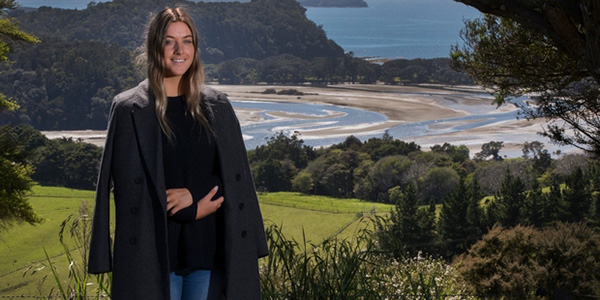
Presidential Presence: Like her father and his father, Rupert Berger—the latter’s funeral, in 1997, was the biggest ever seen in Pūhoi—Tessa Berger has the charisma community groups can usually only dream of having in their elected leaders. photographer Nick Reed New Zealand Herald
Her Facebook lit up. It is clear from the rapturous response to the New Zealand Herald article featuring newly elected Mahurangi Action president Tessa Berger, that Facebook is an essential tool in spreading the Mahurangi Coastal Trail message.
To land a glowing half-page account on page seven of the nation’s most widely read Saturday-morning newspaper doesn’t happen by accident. The planets that aligned on this occasion were the reporter in question, Wayne Thompson, attending a meeting of Auckland Council’s parks, recreation and sport committee at which the coastal trail was on the agenda, and the availability at short notice of Mahurangi Action’s photogenic then president-elect.
In the increasingly desperate print-media market, stories that prove to be sufficiently popular will generally be followed up energetically by the newspaper involved, and 68-year-old white male activists should seldom attempt to be the face of the future. Mind, 66-year-old Jeremy Corbyn and 74-year-old Bernie Sanders are currently succeeding in being just that in the United Kingdom and United States. So, having grabbed one prime print-media spot, the best prospects for building mainstream-media exposure is for as many friends as possible of the Mahurangi Coastal Trail, and of Tessa Berger, to share the New Zealand Herald story Coastal Trail Dream for Untouched Paradise on Facebook or other social media platforms.
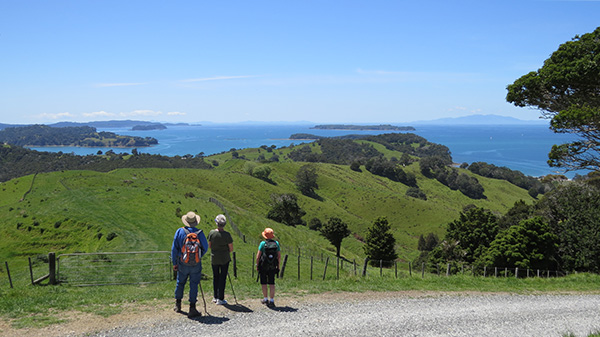
Sublime Prelude: Even after a gentle two-kilometre walk, this vista of the Mahurangi coastline and islands is a tonic, but for any Te Araroa walkers who left the coast at Pakiri an often-gruelling 60-kilometres earlier, probably unadulterated euphoria. For cars to commandeer this sacred pathway in order to crowd the beach beyond would be a callous desecration of truly monstrous proportions. image Mahurangi Magazine
The sublime prelude to Saturday’s annual general meeting was walking, what is proposed to be, the missing Pūhoi-to-the-coast section of Te Araroa, but cheating by starting not at the township, because that part of the trail is yet to be formed, and starting instead from the terminus of Hungry Creek Road. Until this new parkland is developed, it is strictly off-limits for the public, as walkers were reminded when coinciding with the resident ranger. On this occasion, however, prior permission had kindly been given, and the party was allowed to proceed. Including picnic lunch on Te Muri Beach, the walk took two hours, but nearly an hour of that was spent at the innumerable vantage points along the ridge road that just begged to be photographed from—every five minutes offered, it seemed, more spectacular vistas, of the park, the Pūhoi River, Wenderholm, Mahurangi Harbour, and the ‘Eden Islands’ of Motutara, Motureka Moturekareka, and Kawau Island, and of course Saddle Island and Motuora. The views of the clear, incoming tidal flow around the end of the Wenderholm spit, and of a family enjoying its power at close quarters were particularly captivating and deserving of more serious photography than the occasion permitted, given the imperative to catch the ferry to Scotts Landing and the Mahurangi Action meeting.
Te Muri Beach was its predictably all-but-deserted self, although one kayaker, who had read the Wayne Thompson testimony before heading to his favourite destination was incensed, insisting the proposed Mahurangi Coastal Trail would be the ruination of the place. When asked if he would prefer the alternative of a road and car-parking for thousands, he was adamant that neither was acceptable. His humour was visibly not improved when his partner readily accepted that change was likely inevitable and in that case a coastal trail was greatly preferable to vehicle access. The half-hour walk from the camp ground to the terminus of Ngārewa Drive, including shedding boots, drying feet and replacing boots after wading across the estuary, was a reminder that, even with all-tide access from Wenderholm and Mahurangi West, the percentage of visitors to the greater Mahurangi Regional Park prepared to put in the effort to walk to Te Muri will only ever be small.
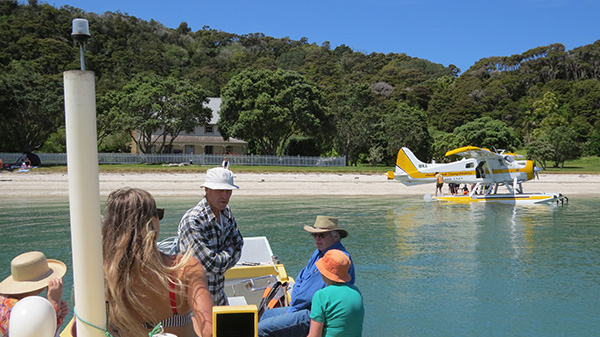
Surreal Encounter: Recognised the second she stepped ashore from her exposure in that day’s New Zealand Herald, Mahurangi Action’s president-to-be, Tessa Berger, centre, was interviewed by an Auckland Tourism, Events and Economic Development staff member for a potential role in a promotional video. image Mahurangi Magazine
From Sullivans Bay to Scotts Landing, by road, is a tortuous and often-congested 37 kilometres. A ferry service linking the parts of the Mahurangi Regional Park—Scotts Landing, Mahurangi Peninsula and Mahurangi West, will one day form an integral part of the how the park functions. It is likely that the Mahurangi Regatta will provide the earliest proof of concept, where the need to connect the picnic regatta at Sullivans Bay with the prize-giving dance at Scotts Landing has long been apparent. Ultimately, a ferry service would also link to Saddle Island, Motuora and run upstream to Warkworth. Meantime, on Saturday, the one-time oyster barge Pooh magic-carpeted Mahurangi Action members gently across the harbour, picking up an aerial escort along the way in the form of a de Havilland Beaver float plane, which taxied in just ahead. Its passengers, it transpired, were United States emigrants and prospective Mahurangi residents, being filmed in their quest. They were meet at the beach by an Auckland Tourism, Events and Economic Development staff member, who, had time permitted, would have also filmed Mahurangi Action’s sole candidate for the presidency, resulting in a fascinating 20-minute-longer-than-planned afternoon tea on the veranda of Scott Homestead, prior to the delayed-but-not-prolonged annual general meeting.
By virtue of previously circulating minutes of the previous annual general meeting, and the annual report for the current one, formalities took an entirely bearable 25 minutes. Had a detailed annual report been read it would perhaps made for the longest Mahurangi Action meeting in its 41 years, bar the extraordinary committee meeting held to repel the efforts of a rogue chairman who fancied executive privilege allowed him to discharge the society’s undertaking to Dr Ronald Locker’s widow by passing off 80 photocopies of a version of Jade River : A History of the Mahurangi, stripped of all artistic white space, to those who had paid $20 deposits six years earlier. The agenda alone for that meeting ran to 32 pages, burying once and for all the deranged threat to the history’s publication of 1000 copies, which sold out in 6 months, with the second edition print run of 1000 lasting until the early 2010s.
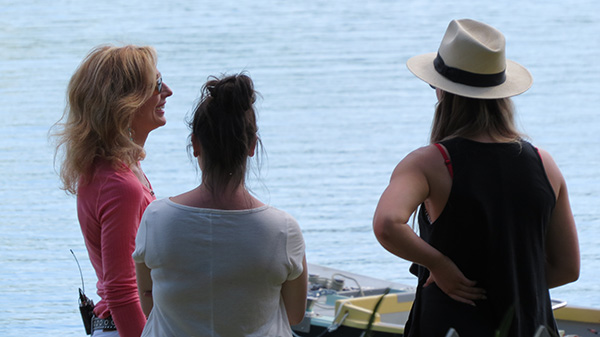
Third of Committee Right There: Election of a third of Mahurangi Action’s six-strong committee, film student Caitlin Owston-Doyle, middle, and Tessa Berger, right, was delayed 20 minutes while an Auckland Tourism, Events and Economic Development staff member, left, worked on ways to tie Tessa into an upcoming video shoot. image Mahurangi Magazine
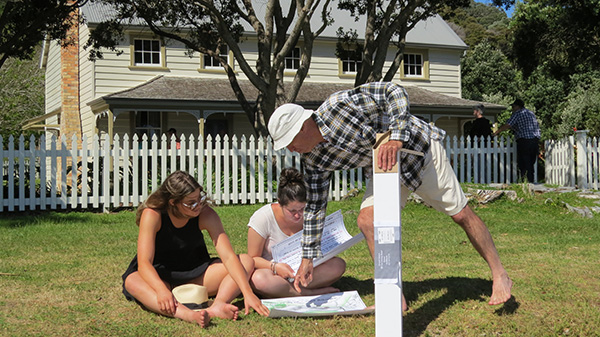
Vision of the Future: While the average age of Mahurangi Action members currently closer to 60-something, with these two 20-somethings now making up a third of the committee, and the new president’s New Zealand Herald article being shared 176 times on social media within a week, the people who are going to have to brave a globally warmed world are rightly beginning to call the shots. Right, Jefferson Chapple detailing an element of the Mahurangi River environment precinct concept he rendered. image Sarah Ransom
The 2014–2015 year saw:
- Mahurangi Action’s 40th and the Mahurangi Action Plan’s 10th anniversaries celebrated in fine style
- the Mahurangi Regatta supported by Auckland Council’s regional events fund, with $2000, and with a like sum from the Rodney Local Board’s events budget, and participating yacht and boating clubs consolidating and increasing their contribution
- a principal regatta sponsor, Teak Construction, stepping up with $5000 cash and $3000 in kind, from 2016 onwards
- thanks to a Rodney Local Board initiative, the prospect of Mahurangi Action being recognised and supported as a significant regional event by Auckland Tourism, Events and Economic Development
- in partnership with Auckland Council, the trialling of a pilot programme of awareness raising of builders in the Warkworth area to the need to limit sediment generation, to be followed by a second, more targeted pilot with the emphasis on determining exactly what measures needed implementing, on a site-by-site basis
- a process beginning whereby Mahurangi Action will receive Auckland Council assistance to build capacity to continue progressing the Mahurangi Action Plan, for a finite period, the Mahurangi will enjoy priority catchment status, after which the council will scale back its support
- the Mahurangi Coastal Trail receiving overwhelming support in the initial submission stage of the Auckland Regional Parks management plan review in respect to Te Muri access
- a dialogue begun with Auckland Council on a bulk-purchase concept whereby the council would ensure that some of the funds it grants for the purchase of indigenous plants are spent on those raised by the far more cost-effective open-ground method
- 300 open-ground raised tōtara were planted at two different spacings into the nurse crop established in 2014 on the Mahurangi Farm-Forestry Trail
- Mahurangi Action assisting the Whitebait Connection deliver two native fish discovery nights—first was held from the weir adjacent Mahurangi College and upstream, the second on the Mahurangi Farm-Forestry Trail, and
- produced, with the help of an $1100 grant from the Rodney Local Board and Jefferson Chapple’s architectural rendering expertise, a Mahurangi River environment precinct concept, with the stated goal of starting a conversation about how the council and community might develop Warkworth’s town basin environment to better delivery Mahurangi Action Plan outcomes.
The meeting ended on a high with re-elected committee member Hugh Gladwell explaining how the last-listed initiative had resulted in the Jane Gifford Trust proposing a jointly convened twice-yearly Mahurangi Harbour forum, aimed to put meat on the bones of the Mahurangi Action Plan: A Catchment Plan 20102030.
And for that meat, there is considerable appetite.
